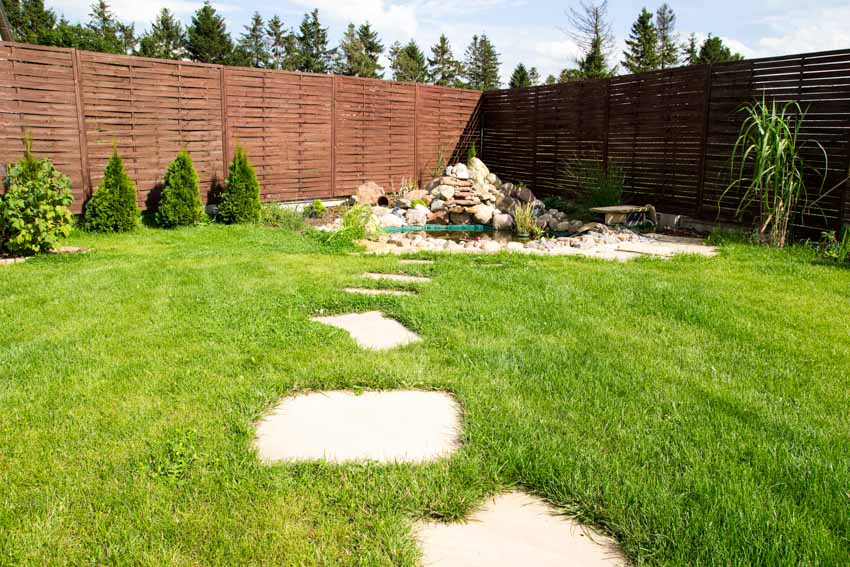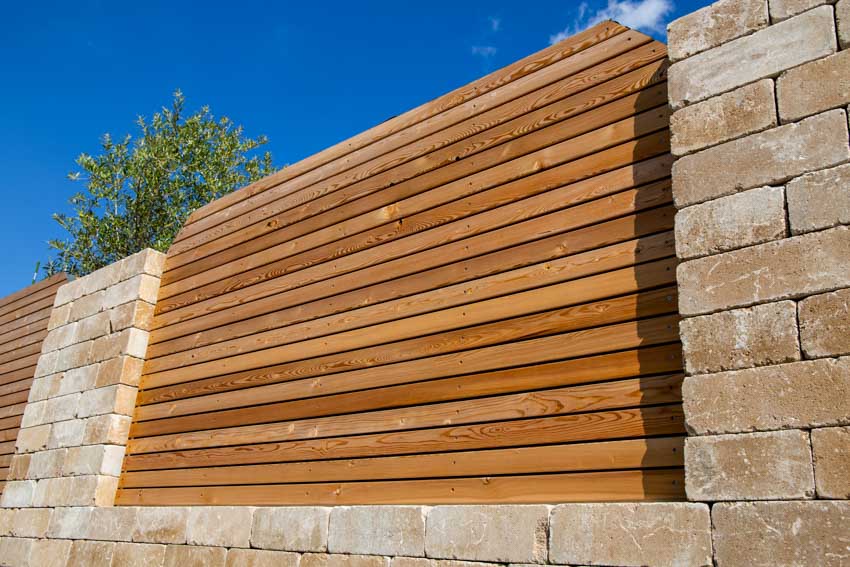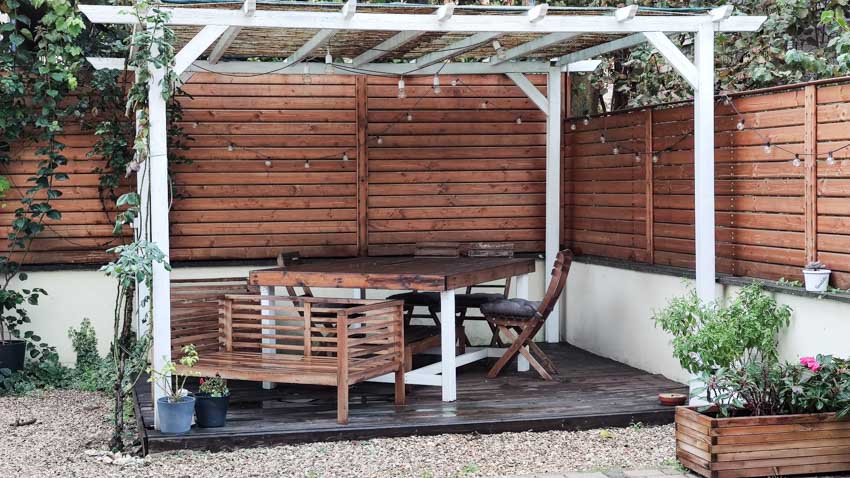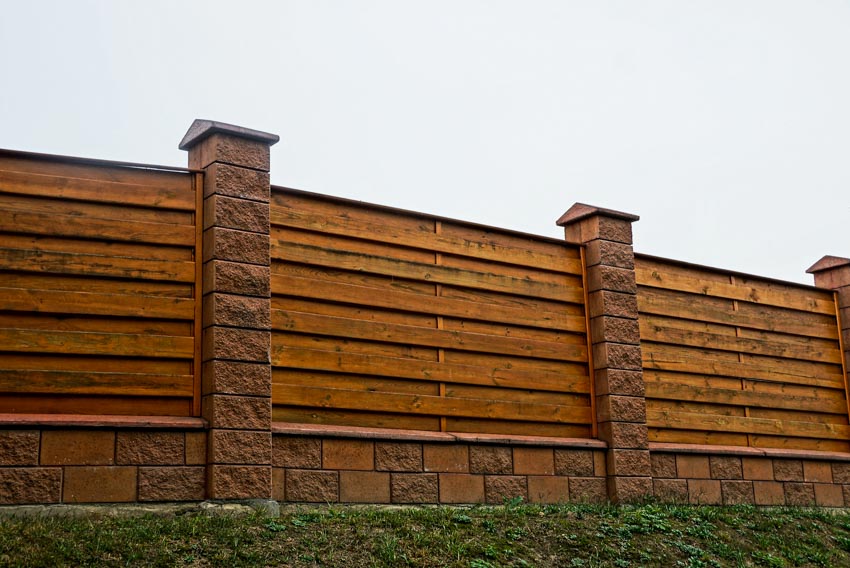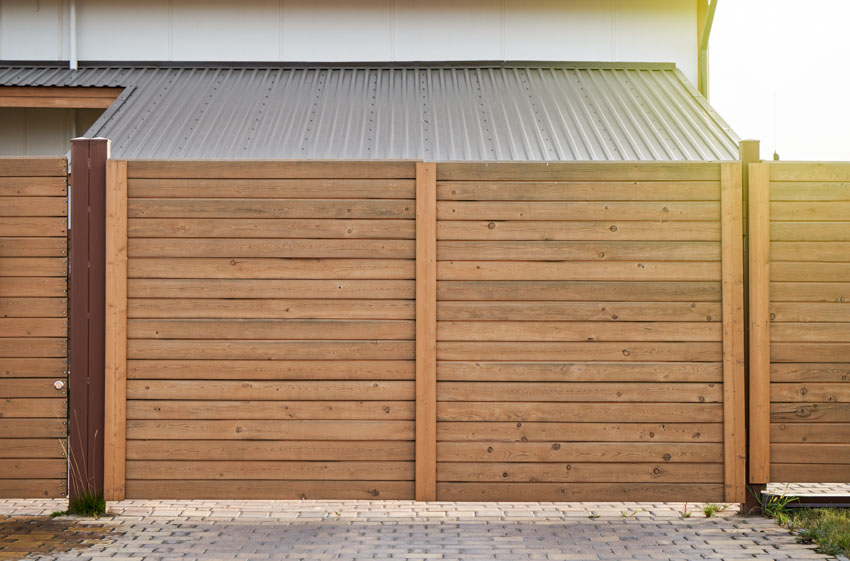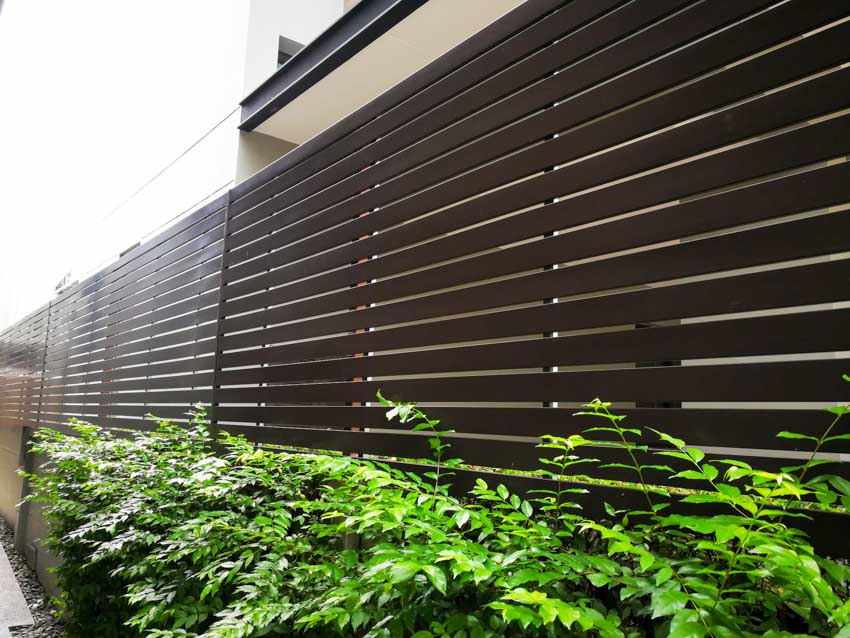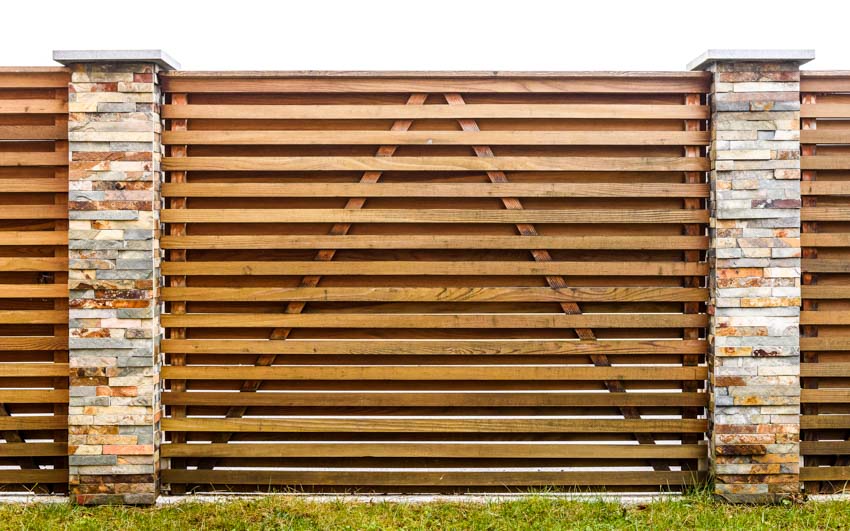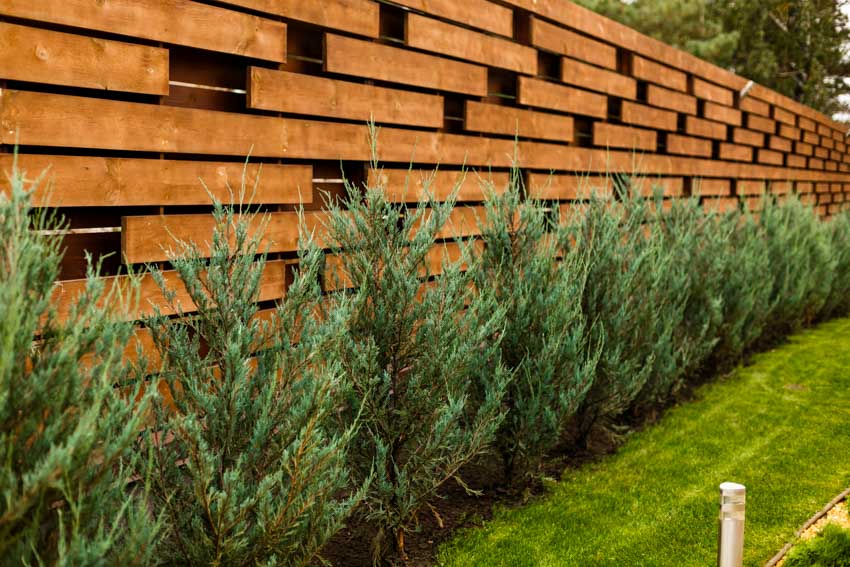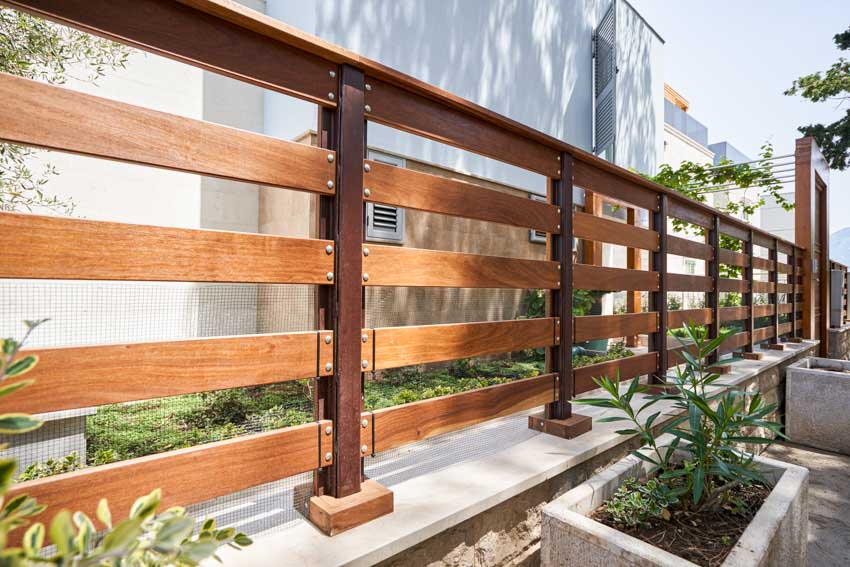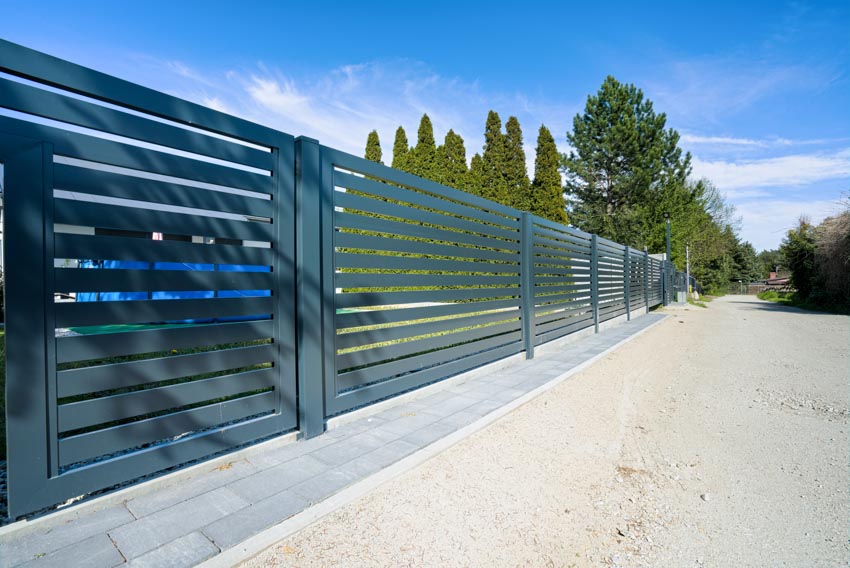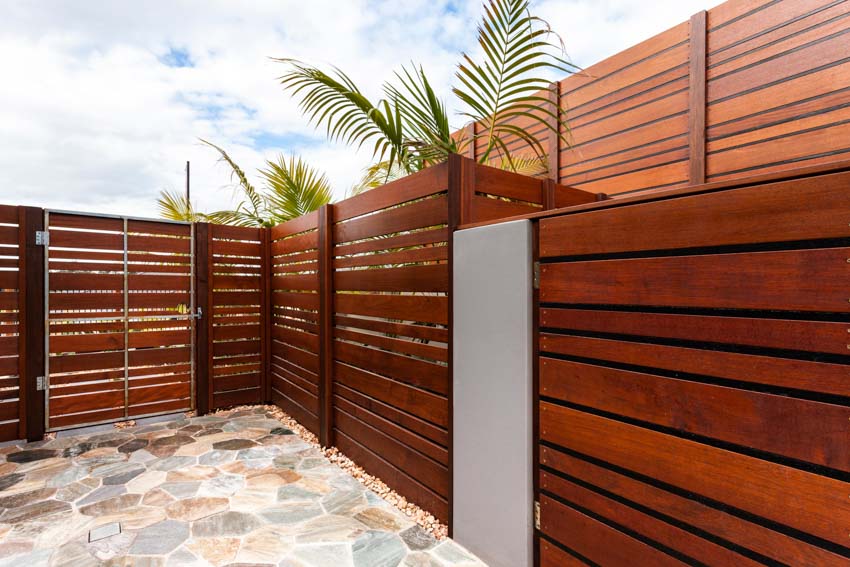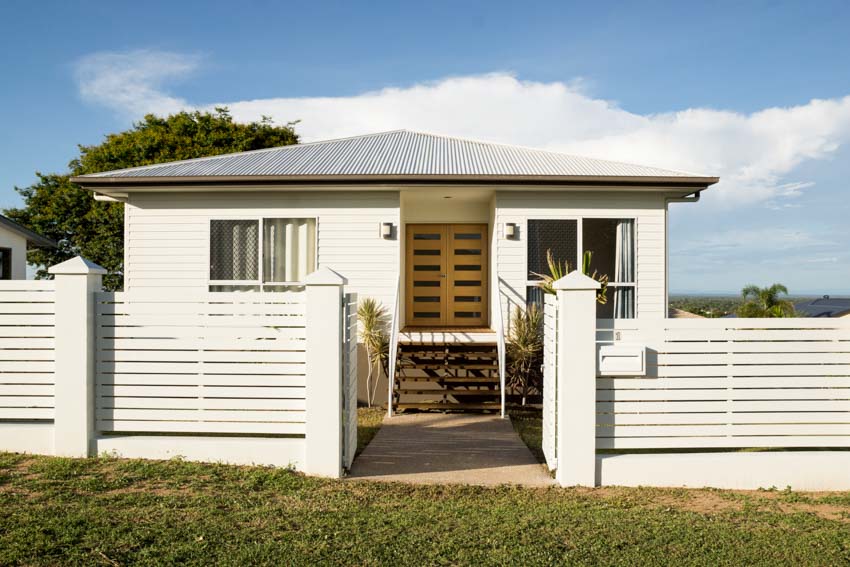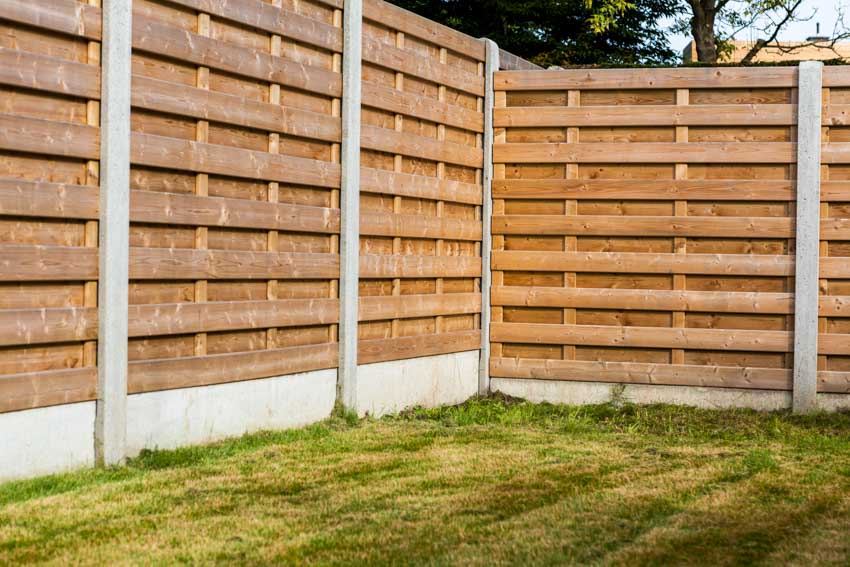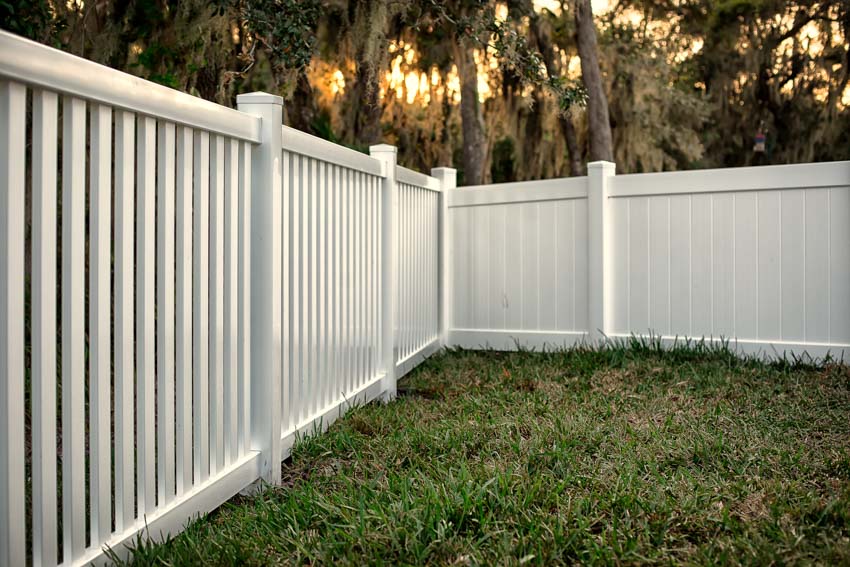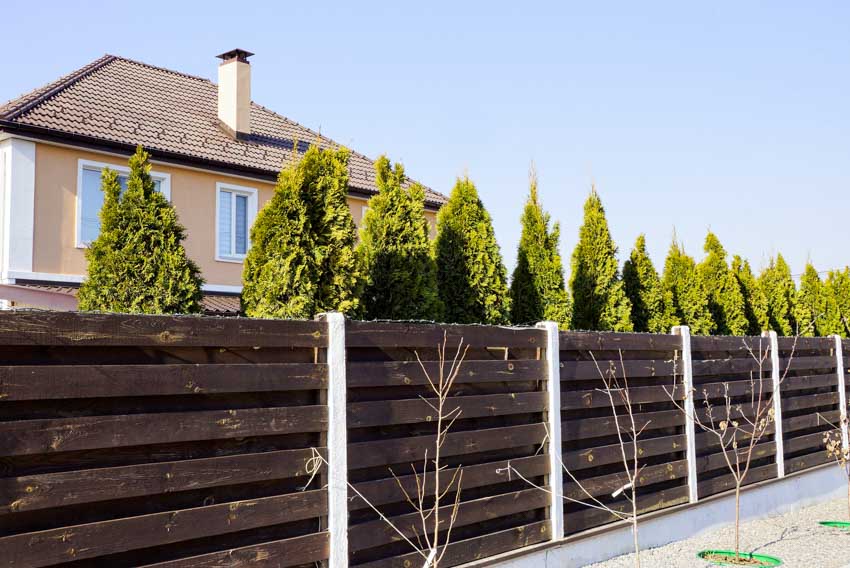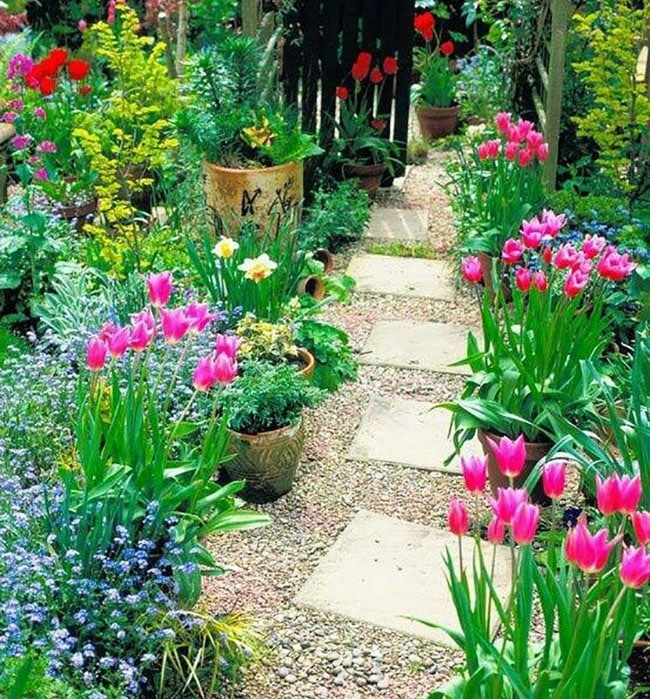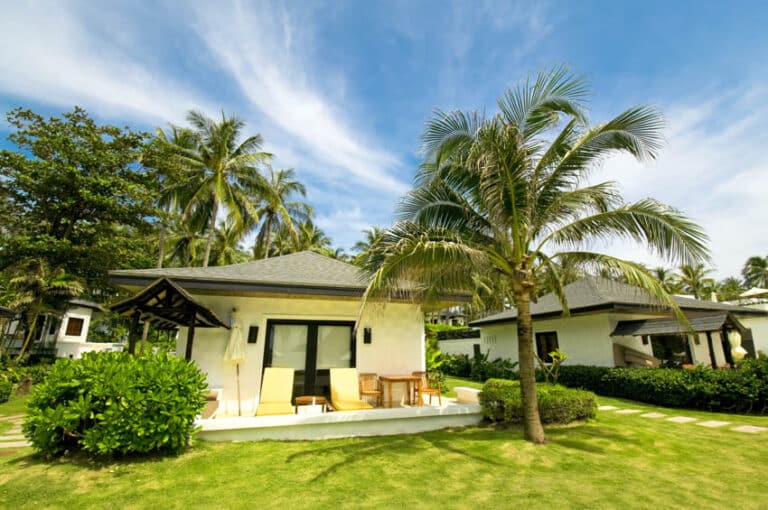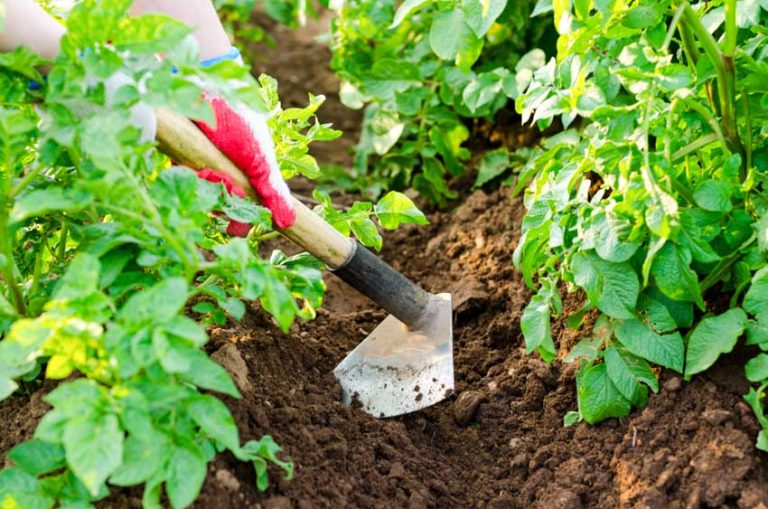17 Horizontal Fence Ideas (Designs & Materials)
Here, we share pictures of horizontal fence ideas and cover what it is, the different designs, materials, cost, and how it compares to vertical fencing.
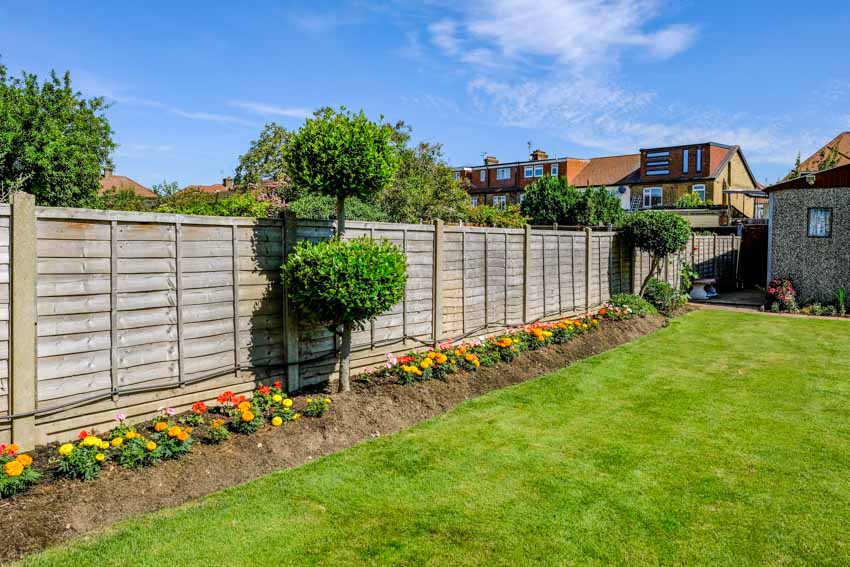
Having a fence around your yard is a great way to get some privacy, keep people or animals out, and create a border if you want to keep someone – like a pet off their leash – inside your own yard.
You have a lot of options when it comes to fencing design. If you want something to stand out on your block, horizontal fencing offers a one-of-a-kind appearance.
What Is Horizontal Fencing?
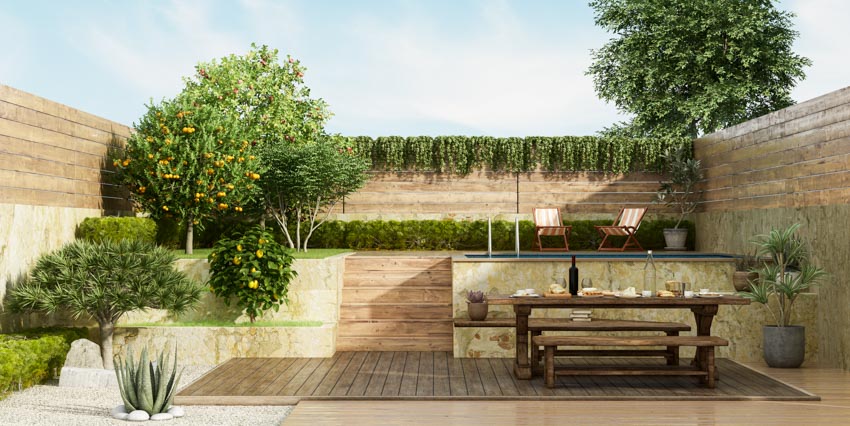
Regarding horizontal vs. vertical fencing, the terms refer to how the slats in the fence are placed. Vertical fences have slats fixed in a position going up and down, while horizontal slats are placed with the slats fixed to the posts longways, hence the names.
There are quite a few benefits to horizontal fencing. For one, it can help make your yard look bigger and create a unique appearance since vertical fencing is so popular. This fencing is also often praised for its modern appearance. Still, you have a variety of styles and materials to choose from, so you can find something to fit the exact style to fit your home.
There are a few cons to horizontal fencing as well. For one, it’s more difficult to install. This often means homeowners turn to professional installations, which can come at an additional cost.
In addition, while certain horizontal fence ideas can make your yard look larger, they can also make your house look a bit shorter. This is a particular problem for shorter architectural styles such as ranch-style houses. Taller and even multi-story homes don’t worry about this concept as much.
Horizontal Fence Designs
Here are some of the popular horizontal fence designs available.
Horizontal Slat Fence
A horizontal slat fence often references the most straightforward design. In these, the planks are fixed to their posts longways rather than vertically, with varying design differences. You can place them on top of the other in a simple look, like you’d put panels side-by-side for a simple vertical structure like a picket fence.
This style is frequently used to provide a contemporary, modern style with a linear design that helps the space feel larger and gives it a sense of organization. This style and illusion of added space are two major factors that make them so attractive.
Horizontal fence ideas can come in all shapes and forms, and, at their most basic form, a slat design can refer to any barrier with, well, horizontal slats. If you’d prefer something with more privacy or something that seems a bit more eccentric and one-of-a-kind, those options are available as well.
You can install horizontal slat fences in a variety of materials, too. From wood to vinyl to composite and even metal, your chosen material can change how it looks and feels aesthetically and practically.
Horizontal Board Panels
Fence panels are a section of fencing already constructed. This makes it easier for you to install the fence when you’re ready. After all, the panels are already constructed; it’s just mostly left to set them up and fix them into place.
Most commonly, you’ll see this with vertical fence panels. These usually have an area of fencing measured from post to post. However, it isn’t a practice solely left to vertical fencing. You can find fencing panels for horizontal fencing as well. Yet, these types of panels aren’t as common as their vertical counterparts.
Horizontal panels come in a variety of designs and styles, too, so you can find something to suit your design style. If you opt for fencing panels, you aren’t necessarily limited to the basics. Again, though, you probably won’t find as many horizontal fencing options in the form of pre-made panels compared to vertical fencing options.
Modern Horizontal Board On Board
Horizontal fence ideas, as a whole, are often praised for their modern appeal. This is partly thanks to the traditionality associated with vertical fencing. It’s long been the most common form of fencing.
We’ve started turning to horizontal fencing in recent, more modern times. Along with metal and wood, this style is offered in more modern materials, including vinyl and composite fencing.
Still, this isn’t to say that horizontal fencing only appeals to those who love modern decor and design, but choosing neutral colors and clean lines will help you capture the modern appeal you might be looking for. You can even shake things up with some staggered planks or use a shadow box method in building your modern fence.
Horizontal Privacy Fence
Privacy fences are a great touch when you want more discretion when you spend time in your yard. Not to mention, they still offer all of the other benefits of a fence, and their tall designs are excellent for keeping pets in your yard, for example.
A privacy fence is usually at least six feet high, and they don’t typically let much light in from either side. This is perfect for ensuring no one can see through to the other side of the barrier. If six feet isn’t tall enough, some homeowners opt to make their privacy fence a foot or two higher.
Certain horizontal fence ideas lend themselves well to the design. When positioned properly, it’s easy to block out visuals with paneling. Some designs, such as a shadow box design, are noted to work more efficiently with horizontally placed styles rather than vertical ones.
Staggered Horizontal Gap Fence
Distinct staggered horizontal fence ideas use panels that don’t line up perfectly in one way or another or, as the name puts it, staggered. Staggered fences can also vary on which side of the structure boards go on, but this is usually referred to as a shadow box fence rather than a staggered one.
You have some room for how you want to design your staggered horizontal fence, too. If you want privacy, you can stagger your planks but keep them relatively close together. This way, they still block out the visuals on the other side of the fence.
Alternatively, you can get creative with a staggered design that’s more artistic and aesthetic than for privacy. The general rule of thumb is this: if you want to create a staggered design that offers more security and privacy, keep your panels tight!
Horizontal Shadow Box Fence
Horizontal shadow box fences are great to keep a good relationship with your neighbors. After all, they’re often called a “good neighbor” fence because the design ensures both sides of the barrier are equally attractive.
This is because the boards aren’t all mounted on one side of the posts. Rather, the pattern alternates, including switching sides of the fence for each new board.
This also gives your fence a unique, three-dimensional design since it will show the space between the layers. This effect is more pronounced since the panels on each side aren’t perfectly lined up edge-to-edge.
Another benefit to using this pattern is that it offers more privacy. This is because while you can see through the slats at an angle, it’s much harder to happen across this angle when the slats are positioned horizontally.
Materials For A Horizontal Style Fence
Here, we share the different materials that can be used for these horizontal fence ideas.
Wood Fence
First, it’s worth noting that wooden fences can vary greatly depending on the type of wood you use. However, this also gives you a lot of variety to choose from, in both pros and cons and appearances. Overall, though, there are some general pros and cons for wood for horizontal fencing.
For one, wood is readily available, and while costs can vary depending on the type of wood, there are plenty of affordable options. Options like certain types of cedar fences will be much more affordable than an option like white oak. Another benefit to this variety is that you can choose a wood type to fit your preferences and budget.
Of course, there are some drawbacks to wood fencing. For one, while different types of wood may resist problems like pests, they’re usually more temperamental to humidity and climate, making them more prone to cracking or warping. However, leaving the proper space during installation can help minimize these effects.
Metal Fence
You have a few options for using metal in your horizontal fencing. First, let’s take a look at aluminum fencing. This type of fencing has various benefits, from its durability to the minimal maintenance it requires.
However, it does have lower durability as aluminum is a malleable metal. While vertical aluminum fences don’t often offer much privacy, horizontal designs tend to use wider panels, offering more coverage. As for cost, aluminum fencing costs an average of about $7 to $32 per foot of materials.
Another option you have as far as metal products go is a horizontal corrugated metal fence. Corrugated metal is galvanized, shaped sheet metal, which is a sustainable and incredibly lasting choice for landscaping. Their design can also help drain water away from your yard – helping you and requiring little maintenance at the same time.
On the other hand, corrugated metal fences can have limited options when it comes to appearance, and they do bounce sound, potentially giving your yard a bit of an echo. The average cost of corrugated metal fencing is usually about $10 to $12 per linear foot.
Composite Fence
As the name suggests, composite fences are made up of a composition of materials, usually a mix of plastic and wood. This approach is meant to be more eco-friendly, and they have a variety of unique benefits.
For one, maintenance is minimal – you can get away with washing it with water when it looks like it needs a cleaning. You can also rely on composite fencing to hold up well against a variety of common catalysts for problems, including UV rays, climate, mold, and insects.
Still, composite fencing is more costly than traditional wood boards. You can expect an average of about $25 per foot, but they can run higher, depending on what you choose.
The good news is that this is the major drawback associated with composite fences – there aren’t many operational disadvantages to the material aside from the increased upfront investment.
Some of the top manufacturers of these materials are Trex, Fiberon, Timbertech and Simtek.
Vinyl Fence
Vinyl is a material with a distinct look. It’s fairly easy to keep clean, and you don’t have to dedicate much time to maintenance, either. In particular, you won’t have to worry about issues like restaining or refinishing vinyl fencing. You also won’t have to worry about pests or water damage. It’s a fairly easy material to install as well.
There are some downsides to vinyl as well, though. For one, some homeowners aren’t a fan of the manufactured appearance of vinyl compared to a more natural option like wood. Another concern comes from damage.
While vinyl lasts and holds up to water well, high temperatures can damage it. This can be a problem since vinyl is also difficult to repair, although it’s a durable choice for horizontal fencing materials.
Most vinyl panels have a height of 4 ft to 6ft tall. However, you can find suppliers that offer 7ft and 8ft high panels. Make sure to check with your local building codes to ensure the height you choose meets the requirements for where you live.
Vinyl fencing does come at a higher upfront cost for this durability. You can expect an average cost of about $15 to $30 on average, depending on the vinyl and fence design you use.
Horizontal Fence Cost
The cost of your horizontal fence can vary depending on a few factors. For one, certain styles and materials may run at a higher cost than others. On average, though, you can expect to pay around $5 to $12 per linear foot of material you need. Of course, larger yards or perimeters will naturally come at a higher cost.
As you place your fence, you’ll need posts to support the panels. The cost of fence posts can vary widely, ranging from as low as $5 to as much as $70 or more. Wood or metal posts run the lowest, while brick and stone posts come at the highest cost.
If you hire a professional to install your fence, this will come at an additional cost. Hiring a team to complete the installation of horizontal fencing for you runs an average of about $15 to $22 per linear foot. This is the typical choice for many homeowners, as horizontally positioned designs are harder to install than vertical ones.
However, if you have some DIY expertise, you may be able to save money by using a fence design software program to plan your layout, visualize your idea, and calculate the amount of materials needed.
Horizontal Vs. Vertical Fence
We briefly touched on some basic differences between horizontal and vertical fencing, but there are more to consider. As far as appearance goes, beyond the position of the slats, vertical fencing is often seen as more traditional, while horizontal fencing is more modern.
Both offer a variety of styles and options to suit various home decor and landscaping styles, but horizontal fencing is often praised for its uniqueness.
Vertical fencing is also known to be more sturdy due to how the fences are built, but horizontal styles can get a stronger boost by using extra vertical posts to support the slats.
Horizontal fences tend to come at a higher cost as well. This is for a few reasons, including that they are often harder to build and have to be built on-site since they aren’t as widely available in pre-made panels as vertical-oriented products. Vertical fences will also fit the ground’s natural contour well, while horizontally positioned designs need a level surface.
Best Wood For A Horizontal Layout Fence
You have a few options for choosing a type of wood for a horizontal fence. Both hardwoods and softwoods are used for this fencing.
One popular softwood choice is cedar for a few different reasons. For one, it’s easy to work with thanks to minimal knots and a tight grain. Plus, it naturally repels insects and isn’t prone to warping. Over the years, though, it does start to turn gray – both the yellow and white versions. It runs at about $3 to $7 per linear foot.
Another option is redwood, a softwood around the same price range as cedar. Redwood fencing is a good option if you want to stain or paint your fence rather than stick with the natural wood tones. Of course, those are beautiful, too, if you prefer redwood’s natural appearance. It’s fire and bug-resistant, but you must watch out for mold and sun damage.
Pressure-treated wood is another common choice for this price range. Usually made with pine, it doesn’t rot and won’t attract bugs. The tradeoff, however, is that it’s more prone to warping, shrinking, and cracking depending, particularly in areas with dry climates.
A popular hardwood option is a white oak, which lasts an incredibly long, and you won’t have to worry about rotting. Still, damp or humid environments can lead to problems like warping. It also costs more, running at about $15 to $40 per linear foot.
Another hardwood option is black locust, which also carries the benefit of high durability and doesn’t need a lot of maintenance. Yet, its rarity comes at a price of $20 to $40 per linear foot on average, making it one of the priciest options.
See more related content in our article about side by side fence on this page.

